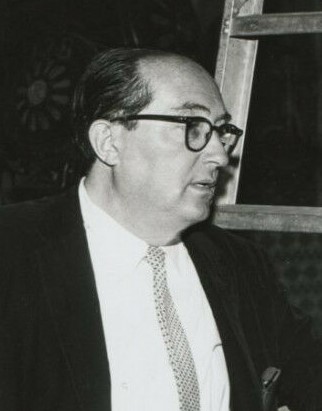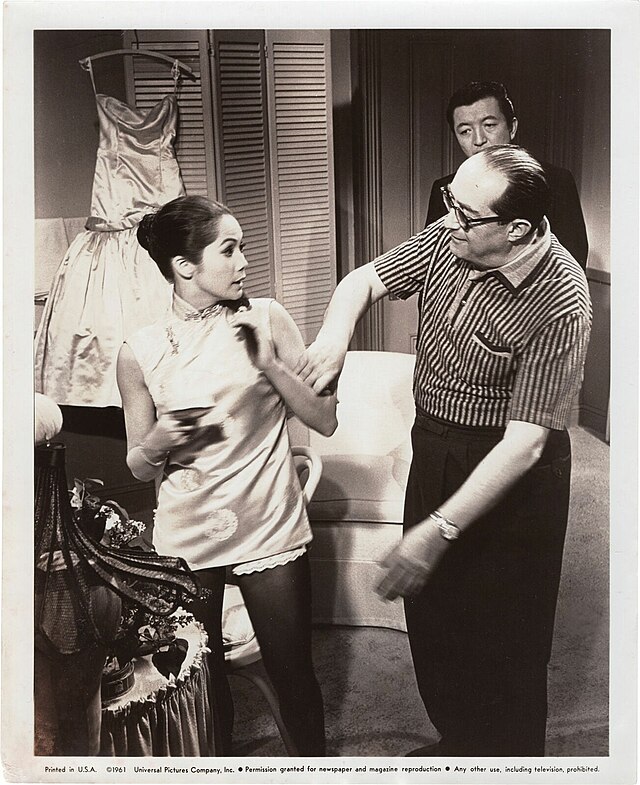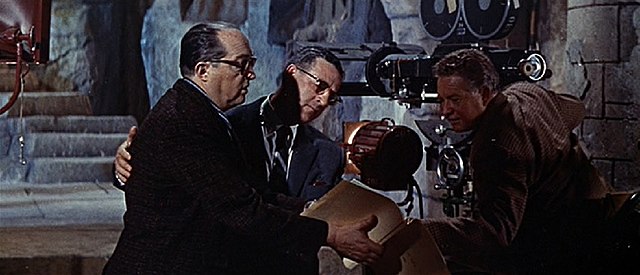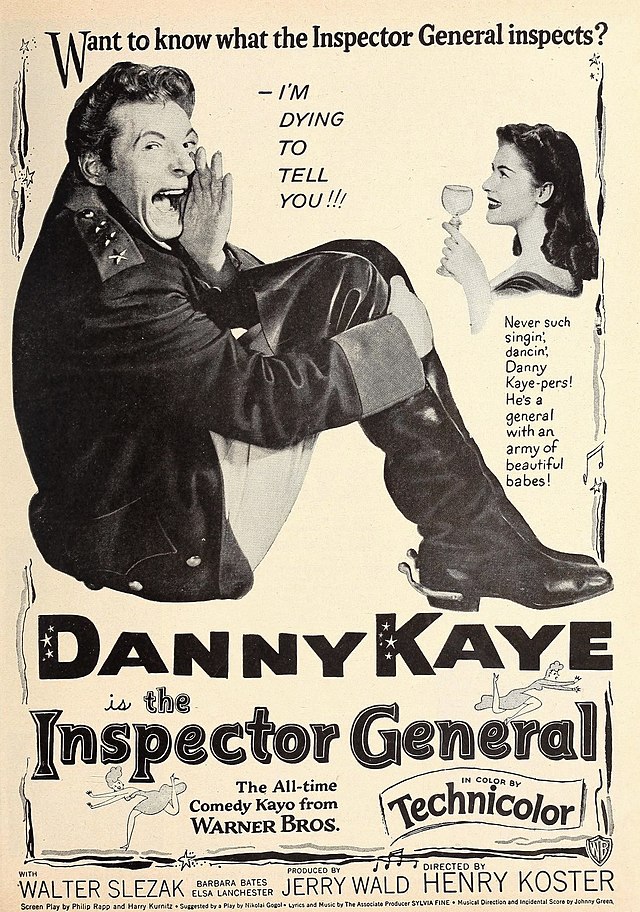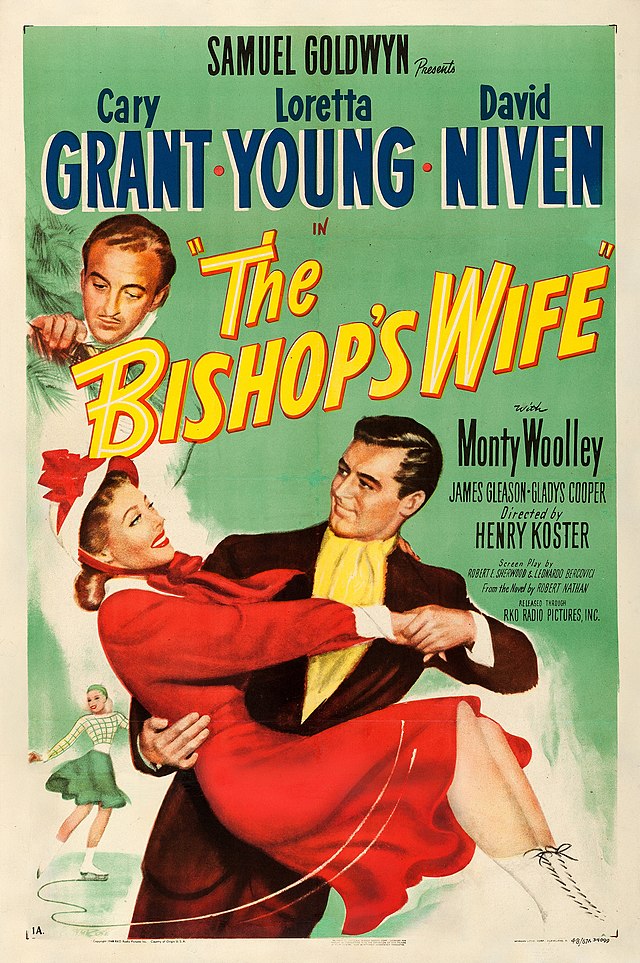Henry Koster
back| Full Name | Hermann Kosterlitz |
| Born | May 1, 1905 |
| Birthplace | Berlin, Germany |
| Died | September 21, 1988 |
| Buried | Hollywood Forever Cemetery, Los Angeles, California, USA |
| Married to | Peggy Moran (actress, married 1942 until his death in 1988) |
| Children | 1 son, Robert Koster |
| Notable films | The Bishop's Wife (1947) - Harvey (1950) - The Robe (1953) - It Started with Eve (1941) |
Henry Koster
The Gentle Director
Henry Koster was a celebrated film director known for his warm, humanistic storytelling. After fleeing Nazi Germany in 1933 due to his Jewish heritage, he found success in Hollywood, directing Three Smart Girls (1936), which helped revive Universal Pictures.
Koster became known for his character-driven comedies and dramas, working with stars like Deanna Durbin and James Stewart. His notable films include The Bishop’s Wife (1947), Harvey (1950), and The Robe (1953), the first CinemaScope film.
Related
Henry Koster (1905 – 1988)
Biography and Movie Career
Henry Koster, born Hermann Kosterlitz on May 1, 1905, in Berlin, Germany, was one of the prominent directors of Hollywood’s Golden Age. His journey to becoming a successful film director in the United States was filled with dramatic turns, shaped by his artistic talent and the historical forces of his time.
Early Life and Beginnings in Germany
Koster was born into a culturally rich Jewish family in Berlin, and his early exposure to the arts spurred a deep love for storytelling. Initially aiming for a career as a novelist, Koster soon shifted his focus to the emerging world of cinema. By the 1920s, German cinema was flourishing, and Koster seized the opportunity to begin his career in film. He started as a screenwriter, working on silent films in Berlin, and by the early 1930s, he was directing. His directorial debut in Germany showed promise, and his talents were recognized in the thriving Weimar cinema scene.
However, Koster's career in Germany was abruptly halted when Adolf Hitler came to power in 1933. As a Jew, Koster was forced to flee the increasingly dangerous political climate. The Nazi regime's persecution of Jewish artists prompted him to first move to France, where he briefly continued his career. By 1936, Koster had emigrated to the United States, a transition that would mark a turning point in his life both professionally and personally.
A New Life in Hollywood
Arriving in Hollywood with little command of English, Koster’s European background and artistic sensibility soon caught the attention of Universal Pictures producer Joe Pasternak, who recognized his potential. Koster’s first American film, Three Smart Girls (1936), was a smashing success. The lighthearted comedy about three sisters determined to reunite their parents helped pull Universal Pictures out of financial distress and cemented Koster’s status as a reliable director.
This success led to a fruitful partnership with Pasternak, and Koster became known for his deft handling of comedy and light family fare, which were in demand during the Depression era. He was praised for his ability to bring warmth and charm to his films, a talent that would serve him well throughout his career.
A Family Man
During this time, Koster’s personal life blossomed as well. In 1942, he married actress Peggy Moran, a popular Universal starlet who had appeared in several films during the 1930s and 1940s. After their marriage, Moran retired from acting to focus on her family, and the couple had one son, Robert Koster. Their marriage was happy and lasted until Henry’s death in 1988. Moran was known for her spirited personality and strong support of her husband’s work, becoming a key figure in his life both personally and professionally.
Career Highlights and Signature Films
Koster continued to build on his early success throughout the 1940s, becoming one of Hollywood’s most sought-after directors for comedies, musicals, and family films. One of his most celebrated works came in 1947 with The Bishop’s Wife, starring Cary Grant, Loretta Young, and David Niven. The film, a heartwarming tale about an angel sent to assist a troubled bishop, earned Koster an Academy Award nomination and further solidified his reputation as a director with a golden touch for feel-good movies.
In 1950, Koster directed what would become one of his signature films, Harvey, starring James Stewart. Based on the Pulitzer Prize-winning play, Harvey tells the quirky story of Elwood P. Dowd, a man whose best friend is an invisible, six-foot-tall rabbit. The film’s offbeat humor and Stewart’s unforgettable performance endeared it to audiences, and it became one of Koster’s most iconic works. His ability to balance humor with heart and create sympathetic, relatable characters was on full display.
Koster was also responsible for another milestone in Hollywood history: he directed The Robe in 1953, the first film ever released in CinemaScope, the widescreen format that revolutionized cinema. The Robe, a biblical epic about the Roman soldier who oversaw the crucifixion of Christ, starred Richard Burton and was a box office triumph. The film’s historical and religious themes, combined with its visual spectacle, marked a new era in filmmaking, with Koster at the forefront of the technical innovation.
A Versatile Talent
Throughout the 1950s and early 1960s, Koster’s versatility as a director was evident. He worked with a wide range of stars, including James Stewart, Debbie Reynolds, and Doris Day, and his films spanned multiple genres—from musicals to family comedies to epic dramas. In Mr. Hobbs Takes a Vacation (1962), another successful collaboration with James Stewart, Koster once again demonstrated his skill in blending humor and relatable family dynamics. The film was a lighthearted look at the trials of family vacations, and Koster’s gentle, humorous touch made it a hit with audiences.
Later Years and Legacy
By the mid-1960s, Koster had largely stepped back from filmmaking. After a career that spanned four decades, he decided to retire from directing and live a quieter life. He continued to be revered in Hollywood as a director who consistently delivered well-crafted, heartwarming films. Koster’s career was not defined by a single genre; rather, he excelled in balancing comedy, drama, and sentiment, making his films resonate with a broad audience.
Henry Koster passed away on September 21, 1988, in Los Angeles, California, at the age of 83. He was laid to rest at Hollywood Forever Cemetery, a fitting resting place for a man whose contributions to film left an indelible mark on Hollywood. His wife, Peggy Moran, survived him and continued to speak warmly of their life together until her own passing.
Koster’s films remain beloved today, with Harvey and The Bishop’s Wife still regarded as classics of American cinema. His ability to evoke both laughter and emotion in his films ensured that he would be remembered as one of the great directors of the Golden Age, a filmmaker whose works continue to bring joy to audiences decades after their creation.
Video Bio on Henry Koster
Humanistic Directing Style
Henry Koster’s directing style is marked by a versatility that allowed him to excel in multiple genres, including comedies, musicals, family dramas, and historical epics. His work is characterized by a humanistic approach that focuses on character development, emotional warmth, and gentle humor. Here’s a deeper analysis of Koster’s key stylistic traits and approaches:
Humanistic Storytelling
At the heart of Koster’s films is his ability to depict human relationships with sensitivity and warmth. Whether he was directing lighthearted comedies or more serious dramas, Koster had a knack for exploring universal emotions like love, friendship, and personal growth. His films are populated by characters who are often kind-hearted, good-natured, and approachable. He made audiences care about the emotional journeys of his characters, fostering an environment of relatability and empathy.
In Harvey (1950), Koster’s focus on Elwood P. Dowd’s unconventional friendship with an invisible rabbit creates a portrait of a man whose charm lies in his innocent and kind nature. The film, while comedic, also resonates with deeper themes of acceptance and individual freedom, delivered with Koster's soft touch.
Character-Driven Comedy
Koster’s strength in comedy lay not in slapstick or exaggerated physical humor but in his ability to draw humor from character interactions and situational irony. His films are often driven by misunderstandings, romantic mix-ups, and the clash of differing personalities, but always with a light, gentle approach. He was adept at balancing humor with emotional depth, ensuring that his comedies resonated beyond just laughter.
In It Started with Eve (1941), for instance, Koster uses a mistaken identity scenario to create comedic tension while also nurturing a sweet romance. The humor feels organic, arising naturally from the characters' behaviors rather than forced comedic setups.
Warm, Sentimental Themes
Sentimentality is a hallmark of Koster’s films, but it never feels overbearing or manipulative. Instead, Koster infused his movies with warmth and optimism, which made his films enduringly popular with family audiences. His films often center on family dynamics, love, friendship, and personal redemption. Rather than dark, gritty themes, Koster gravitated toward uplifting narratives that leave viewers with a sense of hope or emotional satisfaction.
In The Bishop’s Wife (1947), Koster skillfully blends religious themes, family struggles, and romantic tensions into a heartwarming film about faith, love, and renewal. Even though the film tackles significant life questions, it remains light and charming, showcasing Koster’s ability to handle sentimental material without becoming melodramatic.
Strong Performances and Star Collaborations
Koster had a gift for eliciting memorable performances from his actors. He worked with some of Hollywood’s biggest stars, including Cary Grant, James Stewart, Loretta Young, and Deanna Durbin. His direction allowed these actors to shine, often playing to their strengths and creating roles that were tailored to their unique talents. His collaboration with James Stewart in Harvey and Mr. Hobbs Takes a Vacation resulted in some of Stewart’s most beloved roles, highlighting Koster’s ability to let his actors' charm and natural persona carry the film.
Deanna Durbin, in particular, benefited from Koster’s guidance early in her career. Koster directed several of her early films, such as Three Smart Girls (1936) and It’s a Date (1940), shaping her image as a wholesome, youthful star. Koster’s films were often tailored to showcase Durbin’s singing talent and screen presence, helping her rise to stardom.
Technical Innovation and Pioneering Use of CinemaScope
Though primarily known for his warm, character-driven films, Koster was also at the forefront of technical innovation in Hollywood. He directed The Robe (1953), the first movie to be released in the widescreen CinemaScope format. This biblical epic was a visual spectacle that set a new standard for film production, making Koster part of cinema history. While The Robe is more serious and epic in tone than most of Koster’s other films, it still retains his focus on character and emotional depth, even within its grand historical narrative.
His use of CinemaScope in The Robe was a technical achievement, and the film's grand scale and visual beauty showed that Koster was capable of more than the intimate character comedies and musicals that had previously defined his career. He embraced the potential of widescreen filmmaking to enhance the storytelling, creating a rich, immersive experience.
Gentle, Moral Storytelling
Koster’s films often include subtle moral lessons or reflections on ethical dilemmas without ever becoming preachy. His characters tend to undergo personal growth, and there’s usually a clear, redemptive arc, particularly in films like Come to the Stable (1949), which deals with faith and perseverance, or A Man Called Peter (1955), a biographical drama about a prominent preacher. These films communicate positive messages, often related to family, morality, or the power of belief, which resonated with mainstream audiences in mid-century America.
Wholesome Family Entertainment
Koster’s films are frequently regarded as family-friendly, making him a go-to director for feel-good cinema. His ability to blend comedy, romance, and family drama made his films accessible to a broad audience, appealing to both children and adults. Films like Mr. Hobbs Takes a Vacation (1962) and Dear Brigitte (1965) focus on relatable family dynamics, lighthearted conflicts, and humorous situations that were relatable to mid-century American families. His films were often safe choices for family outings and holiday viewing.
Conclusion
Henry Koster’s directing style is characterized by warmth, gentleness, and a focus on the human element of his stories. He had an extraordinary ability to draw authentic performances from his actors, and his comedic touch, mixed with sentimentality, allowed him to create films that were charming, uplifting, and timeless. Whether he was making a musical with Deanna Durbin, a heartwarming fantasy like Harvey, or an epic like The Robe, Koster’s focus was always on the emotional journey of his characters, and his films continue to be cherished for their sincerity and lightheartedness.
Personal Quotes by Henry Koster
On working with actors:
- "If you cast the right actor for the part, 90 percent of your work is done. All you have to do is guide them gently and allow them to bring themselves to the role."
This quote reflects Koster’s belief in the importance of casting and his respect for actors. His gentle direction style allowed stars like James Stewart and Cary Grant to shine in their roles, contributing to the natural and warm performances often seen in his films.
On making The Robe (1953), the first CinemaScope film:
- "I had no idea we were making history, just that we had a much wider screen. My first thought was, ‘Where do I place the actors so they don’t get lost in all that space?’"
Koster humorously reflected on the technical challenges of working with CinemaScope, the widescreen format that revolutionized filmmaking. His practical concern about keeping the focus on the actors shows his dedication to character-driven stories even in the context of a large-scale epic.
On the role of a director:
- "The director is the conductor of a great symphony. His job is to bring out the best in all the instruments—the actors, the script, the music, the design—so they can all work in harmony."
This quote illustrates Koster’s philosophy of collaboration and his view of the director as a guiding hand that brings together various elements of a film to create a unified experience.
On comedy and family films:
- "Laughter and love are universal. If a story can touch the heart and make you laugh, it can reach anyone, anywhere."
Koster often worked on comedies and family films that combined humor with sentimentality. This quote emphasizes his belief in the power of laughter and emotion to create films that are accessible to a broad audience.
On his escape from Nazi Germany:
- "When you lose everything, you realize what truly matters. For me, it was family and the ability to keep telling stories, no matter where I was."
Koster fled Nazi Germany in the 1930s due to his Jewish heritage, and this experience had a profound impact on his life and career. His resilience and optimism, even after losing his career in Europe, can be felt in this quote, which speaks to his determination to continue creating films.
On directing Harvey (1950):
- "The beauty of Harvey is that it’s a film about belief and kindness. It reminds us that sometimes the world needs a little magic, even if it’s only a six-foot-tall invisible rabbit."
Harvey became one of Koster's most iconic films, and this quote captures his understanding of the film’s charm and its central themes of imagination, acceptance, and kindness.
What Others said about Henry Koster
James Stewart, who worked with Koster on several films including Harvey (1950) and Mr. Hobbs Takes a Vacation (1962), spoke highly of his directorial style:
- "Henry had a way of making the set a calm, happy place. You never felt rushed or pushed, and he always knew how to get the best out of people without them even realizing it."
Stewart admired Koster’s relaxed and warm approach, which allowed actors to feel comfortable and deliver natural performances.
Peggy Moran, Koster's wife and a former actress, often talked about his nurturing nature and how that carried over into his work:
- "He was a kind man, always thoughtful and considerate. He treated everyone with respect, whether it was a star or a stagehand. That’s why so many people loved working with him."
Moran emphasized Koster’s collaborative and respectful attitude on set, which made him well-liked in the industry.
Joe Pasternak, the producer who first hired Koster at Universal Pictures and worked with him on several successful films, praised his consistency and talent:
- "Henry had a golden touch. Everything he did was filled with charm and grace. He brought Deanna Durbin to life and made audiences fall in love with her. He had an instinct for what worked."
Pasternak credited Koster with being instrumental in reviving Universal Pictures’ fortunes in the 1930s, particularly with their collaborations on Deanna Durbin’s films.
Richard Burton, star of The Robe (1953), praised Koster’s directorial ability on large-scale productions:
- "Henry had an extraordinary ability to make something as grand as The Robe feel intimate. He focused on the characters and the human element, even amid all the spectacle."
Burton admired Koster’s balance between epic storytelling and his focus on the characters’ emotional depth.
Deanna Durbin, who became a major star under Koster’s direction, once remarked:
- "Henry understood me as an actress, and he knew how to bring out the best in me. He was patient, kind, and always there to guide me. I owe much of my career to him."
Koster’s influence on Durbin’s career is widely recognized, and she often credited him with helping her transition from child star to a leading lady.
Awards and Recognition
Henry Koster had a successful career, but he was not as frequently recognized in major award categories as some of his contemporaries. Nonetheless, he received several notable nominations and awards during his long career, primarily related to his work as a director.
Academy Awards (Oscars)
- Nominated: Best Director – The Bishop’s Wife (1947)
The Bishop's Wife, a heartwarming Christmas classic starring Cary Grant, Loretta Young, and David Niven, earned Koster his only Academy Award nomination. The film was praised for its charming blend of romance, faith, and light comedy. However, he did not win the award.
Golden Globe Awards
- Nominated: Best Director – The Robe (1953)
The Robe was the first film released in CinemaScope and earned widespread recognition for its epic scope and technical innovation. Although Koster received a Golden Globe nomination for Best Director, the film's grand scale and religious themes overshadowed his personal nomination.
Venice Film Festival
- Nominated: Golden Lion – My Cousin Rachel (1952)
This romantic mystery starring Olivia de Havilland and Richard Burton earned Koster a nomination for the Golden Lion at the prestigious Venice Film Festival. The film was well-received for its intriguing atmosphere and strong performances.
Directors Guild of America (DGA)
- Nominee: Outstanding Directorial Achievement in Motion Pictures – The Robe (1953)
Koster was recognized by the DGA for his groundbreaking work on The Robe, one of the first films to utilize the CinemaScope widescreen format. This acknowledgment reflected the technical and artistic achievement that the film represented at the time.
Photoplay Awards
- Winner: Medal of Honor – Harvey (1950)
Photoplay, one of the earliest and most influential fan magazines, awarded Koster its Medal of Honor for Harvey, a beloved comedy about a man and his invisible rabbit companion. The award was based on popular vote, highlighting Koster's appeal with mainstream audiences.
Golden Apple Awards
- Winner: Golden Apple Award for “Most Cooperative Director” (1951)
This award is not based on cinematic merit but reflects Koster's reputation in Hollywood as a highly collaborative and well-liked director. The Golden Apple Awards were given by the Hollywood Women's Press Club, and this honor reflects how much Koster was appreciated within the industry.
Academy of Science Fiction, Fantasy & Horror Films, USA
- Nominee: Best DVD Classic Film Release – Harvey (2002 DVD release)
Many years after its release, Harvey was nominated for a Saturn Award in the Best DVD Classic Film Release category. This recognition was a testament to the film’s lasting impact on audiences and its continuing popularity long after its original theatrical run.
Movies Directed by Henry Koster
1936
- Three Smart Girls
A comedy about three sisters who try to reunite their divorced parents. This film was a major success for Universal Pictures and helped the studio recover from financial difficulties.
1937
- One Hundred Men and a Girl
A musical comedy about a young woman who helps her out-of-work father form a symphony orchestra. The film starred Deanna Durbin and was another box office hit for Koster.
1938
- Mad About Music
A charming musical about a boarding school girl who invents a famous father to avoid embarrassment. Deanna Durbin starred once again, continuing her successful collaborations with Koster. - That Certain Age
A romantic comedy where a teenage girl falls in love with an older man, only to discover he is romantically interested in someone else. Another film with Deanna Durbin.
1939
- Three Smart Girls Grow Up
A sequel to Three Smart Girls, this film follows the further romantic adventures of the three sisters as they grow older and face new challenges in their love lives. - First Love
A Cinderella-style romantic comedy about a teenage girl (Deanna Durbin) who finds herself in a whirlwind romance. This film featured Durbin’s first on-screen kiss.
1940
- Spring Parade
A light musical about a Hungarian peasant girl who dreams of a better life in Vienna. Deanna Durbin leads the film, which is filled with songs and a fairy-tale quality. - It’s a Date
A romantic comedy featuring Deanna Durbin as a young actress competing with her own mother for a role in a new play—and for the attention of a handsome man.
1941
- Nice Girl?
A romantic comedy about a young woman (played by Deanna Durbin) who gets caught up in misunderstandings regarding her romantic intentions, leading to a series of comedic mix-ups. - It Started with Eve
A classic romantic comedy where a man convinces a stranger to pose as his fiancée to please his dying father, only to have complications arise when the ruse becomes more complicated. Stars Deanna Durbin and Robert Cummings.
1943
- Hers to Hold
A wartime romance where Deanna Durbin's character falls in love with a pilot during World War II. The film blends romance with patriotic themes of the era.
1944
- Christmas Holiday
A noir drama in which a young bride finds herself married to a criminal, forcing her to make difficult choices. This film was darker in tone compared to Koster's usual work, starring Gene Kelly and Deanna Durbin.
1945
- Lady on a Train
A murder mystery and comedy where a young woman (Deanna Durbin) witnesses a murder from a train window and gets embroiled in solving the crime herself.
1946
- Because of Him
A romantic comedy about an ambitious waitress who tricks her way into a starring role opposite a famous stage actor. Starring Deanna Durbin, Charles Laughton, and Franchot Tone.
1947
- The Bishop’s Wife
A heartwarming Christmas classic where an angel (Cary Grant) helps a bishop (David Niven) regain his faith and save his marriage. The film is a beautifully made feel-good movie and remains one of Koster's most celebrated works.
1948
- The Luck of the Irish
A fantasy-comedy about a reporter who encounters a leprechaun while traveling in Ireland, leading to a series of magical and humorous events that alter his life. - Mr. Peabody and the Mermaid
A whimsical romantic fantasy in which a middle-aged man discovers a mermaid and falls in love with her, causing complications in his ordinary life.
1949
- Come to the Stable
A drama-comedy about two nuns who arrive in New England with the mission of building a children's hospital, and despite numerous obstacles, their faith and determination win over the townspeople.
1950
- Wabash Avenue
A musical set in the Chicago entertainment scene, where a performer tries to regain his footing after being wrongfully pushed out of a successful show. - Harvey
One of Koster’s most famous films, Harvey is a charming comedy about Elwood P. Dowd, a man whose best friend is an invisible, six-foot-tall rabbit named Harvey. James Stewart delivers one of his most beloved performances in this film.
1951
- Elopement
A romantic comedy about a young couple who decide to elope, much to the dismay of their conservative parents. The film blends comedy with the trials of young love.
1952
- My Cousin Rachel
A romantic mystery film based on the novel by Daphne du Maurier, about a young man who falls in love with his enigmatic cousin while suspecting her of having killed his guardian.
1953
- The Robe
An epic historical drama and the first movie filmed in CinemaScope. It tells the story of the Roman tribune who oversaw Christ’s crucifixion and later converts to Christianity. Starring Richard Burton, the film was a major success and a milestone in cinematic history.
1954
- Desirée
A historical drama about Désirée Clary, a woman who was once Napoleon’s fiancée, and how her life intertwined with his. Starring Marlon Brando as Napoleon and Jean Simmons as Désirée.
1955
- A Man Called Peter
A biographical film about Peter Marshall, a Scottish preacher who became the Chaplain of the U.S. Senate. The film focuses on his inspirational life and career.
1956
- D-Day the Sixth of June
A World War II drama about the love affair between a British woman and two soldiers, set against the backdrop of the D-Day landings. The film stars Robert Taylor and Dana Wynter.
1957
- My Man Godfrey
A remake of the 1936 screwball comedy, where a wealthy woman hires a homeless man as her butler, only to discover that he’s more than meets the eye.
1958
- Fräulein
A romantic war drama about a German woman who helps American soldiers during World War II, and her relationship with a U.S. officer.
1959
- The Naked Maja
A historical romance about the love affair between the famous Spanish artist Francisco Goya and his muse, the Duchess of Alba.
1960
- The Story of Ruth
A biblical epic telling the story of Ruth, a Moabite woman who converts to Judaism and becomes the great-grandmother of King David. The film was praised for its sensitive treatment of the Old Testament story.
1961
- Flower Drum Song
A musical based on the Rodgers and Hammerstein Broadway show about Chinese immigrants adapting to life in San Francisco. The film explores themes of tradition, modernity, and romance.
1962
- Mr. Hobbs Takes a Vacation
A family comedy about a father (James Stewart) who plans a relaxing beach vacation with his family, only to have everything go hilariously wrong. This lighthearted film was a commercial success.
1963
- Take Her, She’s Mine
A comedy about a father (James Stewart) struggling to deal with his daughter’s growing independence as she heads off to college and embraces the counterculture of the 1960s.
1964
- Dear Brigitte
A family comedy about a boy with a genius-level IQ who becomes obsessed with writing to the famous French actress Brigitte Bardot, to the bewilderment of his father (James Stewart).
1965
- The Singing Nun
A musical biopic based on the true story of Sister Luc-Gabrielle, a Belgian nun who achieved fame for her singing. The film starred Debbie Reynolds and was a sweet, inspirational story about faith and music.

